
This incomplete list of works by Titian contains representative portraits and mythological and religious works from a large oeuvre that spanned 70 years. (Titian left relatively few drawings.) Painting titles and dates often vary by source.

This incomplete list of works by Titian contains representative portraits and mythological and religious works from a large oeuvre that spanned 70 years. (Titian left relatively few drawings.) Painting titles and dates often vary by source.
| Image | Title | Date | Dimensions | Collection |
|---|---|---|---|---|
 | Detroit Trio (The Appeal) | c. 1500 | 84.5 x 69.2 cm | Detroit Institute of Arts (Detroit). Also attributed to Giorgione and Sebastiano del Piombo |
 | Christ Carrying the Cross | 1505 | 68.2 × 88.3 cm | Scuola Grande di San Rocco (Venice). Also attributed to Giorgione. [1] |
 | Madonna and Child ( Bache Madonna ) | c. 1508 | 45 × 55 cm | Metropolitan Museum of Art (New York) |
 | Flight into Egypt | c. 1508 | 206 × 336 cm | Hermitage Museum (Saint Petersburg) |
 | Christ and the Adulteress | c. 1508–1510 | 139.3 × 181.7 cm | Kelvingrove Art Gallery and Museum (Glasgow) |
 | Portrait of a Man ( A Man with a Quilted Sleeve ) | c. 1508–1510 | 81.2 × 66.3 cm | National Gallery (London) [2] |
 | Portrait of a Lady (La Schiavona) | c. 1509–1510 | 117 × 97 cm | National Gallery (London) [3] |
 | Pastoral Concert | c. 1510 | 118 × 138 cm | Louvre (Paris) [4] |
 | Portrait of a Man in a Red Cap | c. 1510 | 82 × 71 cm | Frick Collection (New York) |
 | The Lovers | c. 1510 | 74.5 x 65.2 cm | Royal Collection (Windsor). Attributed to Titian |
 | St. Mark Enthroned | 1510/11 | 218 × 149 cm | Santa Maria della Salute (Venice) |
 | The Jealous Husband | 1511 | 340 × 207 cm | Scuola del Santo, Padua |
 | Miracle of the Irascible Son | 1511 | 340 × 207 cm | Scuola del Santo, Padua |
 | Miracle of the Newborn Infant | 1511 | 340 × 355 cm | Scuola del Santo, Padua |
 | Noli me tangere | c. 1511–1515 | 109 × 91 cm | National Gallery (London) [5] |
 | Woman with a Mirror | c. 1511–1515 | 96 × 76 cm | Louvre (Paris) [6] |
 | An Unknown Man | c. 1512 | 73.7 x 62.2 cm | National Trust (Ickworth House) |
 | The Three Ages of Man | c. 1512 | 106 × 182 cm | National Gallery of Scotland (Edinburgh) [7] |
 | Madonna and Child ("The Gypsy Madonna") | c. 1512 | 65.8 × 83.8 cm | Kunsthistorisches Museum (Vienna) [8] |
 | Baptism of Christ | c. 1512 | 115 × 89 cm | Capitoline Museums (Rome) |
 | Balbi Holy Conversation (Madonna and Child with Sts. Catherine and Dominic and a Donor) | c. 1512-1514 | 130 × 185 cm | Magnani-Rocca Foundation (Traversetolo) |
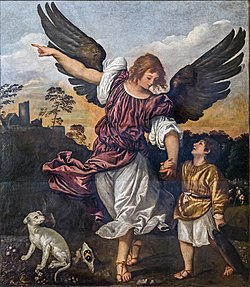 | The Archangel Raphael and Tobias | c. 1512-1514 | 170 × 146 cm | Gallerie dell'Accademia (Venice) |
 | Portrait of Jacopo Sannazaro | c. 1514–1518 | 85.7 × 72.7 cm | Royal Collection (United Kingdom) |
 | Flora | c. 1515 | 79 × 63 cm | Uffizi (Florence) |
 | Portrait of the Physician Gian Giacomo Bartolotti da Parma | c. 1515 | 88 × 75 cm | Kunsthistorisches Museum (Vienna) |
 | Portrait of a Man | c. 1515 | 50 × 45 cm | Metropolitan Museum of Art (New York) |
 | Salome | c. 1515 | 90 × 72 cm | Doria Pamphilj Gallery (Rome) |
 | Kirschenmadonna (Madonna of the Cherries) | c. 1515 | 81 × 99.5 cm | Kunsthistorisches Museum (Vienna) [9] |
 | Vanity | c. 1515 | 97 × 81 cm | Alte Pinakothek (Munich) |
 | Violante | c. 1515–1516 | 64.5 × 51 cm | Kunsthistorisches Museum (Vienna) |
 | Lucretia and her Husband (or Tarquin and Lucretia, and possibly by Palma Vecchio) | c. 1515–1520 | 82 × 68 cm | Kunsthistorisches Museum (Vienna) |
 | An Unknown Man in a Black Plumed Hat | c. 1515–1520 | 70.5 × 63 cm | National Trust (Petworth House) |
 | Sacred and Profane Love | c. 1515–1516 | 118 × 279 cm | Galleria Borghese (Rome) |
 | The Tribute Money | c. 1516 | 75 × 56 cm | Gemäldegalerie Alte Meister, Dresden |
 | Assumption of the Virgin | c. 1516–1518 | 690 × 360 cm | Basilica di Santa Maria Gloriosa dei Frari (Venice) |
 | The Virgin and Child with Saint George and Saint Dorothy | c. 1516 | 86 × 130 cm | Prado Museum (Madrid) |
 | Virgin and Child with Saint John the Baptist and an Unidentified Saint | c. 1515–1520 | 62.7 x 93 cm | Duke of Sutherland, on loan to the Scottish National Gallery (Edinburgh) |
 | The Bacchanal of the Andrians | c. 1518–1519 | 175 × 193 cm | Museo del Prado (Madrid) [10] |
 | The Worship of Venus | 1518–1520 | 172 × 175 cm | Museo del Prado (Madrid) [11] |
 | Malchiostro Annunciation | c. 1520 | 210 × 176 cm | Duomo, (Treviso) |
 | Christ and the Adulteress | c. 1520 | 82.5 × 136.5 cm | Kunsthistorisches Museum (Vienna) |
 | Virgin and Child with Saint Stephen, Saint Jerome and Saint Maurice | c. 1510–1525 | 112.5 × 143.2 cm | Louvre (Paris) |
 | Mary with Child and Saints Stephen, Jerome and Mauritius | c. 1520 | 93.3 × 138.2 cm | Kunsthistorisches Museum (Vienna) |
 | Portrait of Vincenzo Mosti | c. 1520 | 85 × 67 cm | Galleria Palatina, (Florence) |
 | Gozzi Altarpiece | 1520 | 312 × 215 cm | Pinacoteca civica Francesco Podesti, (Ancona) |
 | Averoldi Polyptych | c. 1520–1522 | 278 × 292 cm | Santi Nazaro e Celso (Brescia) |
 | Venus Anadyomene | c. 1520 | 73.6 × 58.4 cm | National Gallery of Scotland (Edinburgh) [12] |
 | Center panel of the Altarpiece of the Resurrection (the Averoldi Polyptych) | c. 1520–1522 | 278 × 122 cm | Santi Nazaro e Celso (Brescia) |
 | Bacchus and Ariadne | c. 1522–1523 | 175 × 190 cm | National Gallery (London) [13] |
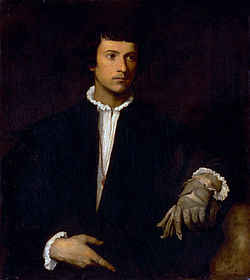 | Man with a Glove | c. 1520–1523 | 100 × 89 cm | Louvre (Paris) [14] |
 | The Entombment | c. 1523–1525 | 148 × 225 cm | Louvre (Paris) [15] |
 | Pesaro Madonna | c. 1519–1526 | 478 × 268 cm | Basilica di Santa Maria Gloriosa dei Frari (Venice) |
 | Altarpiece of San Nicolò della Lattuga | c. 1522–1526 | 388 × 260 cm | Vatican Museums |
 | Portrait of Federico II Gonzaga | c. 1525–1528 | 125 × 99 cm | Museo del Prado (Madrid) [16] |
 | Madonna and Child with Saint Catherine and a Rabbit | 1530 | 71 × 85 cm | Louvre (Paris) |
 | Portrait of Giacomo di Andrea Dolfin | c. 1531–1532 | 101 × 88 cm | Los Angeles County Museum of Art (Los Angeles) [17] |
 | Portrait of a Venetian Nobleman | after 1530 | 108.0 cm × 91.4 cm | Norton Simon Museum (Pasadena) |
 | Portrait of Ippolito de' Medici | 1532–1533 | 139 x 107 cm | Palazzo Pitti (Florence) |
 | Madonna and Child with Saint John the Baptist and Saint Catherine ( Aldobrandini Madonna ) | c. 1532 | 100.6 × 142.2 cm | National Gallery (London) [18] |
 | Portrait of Charles V with a Dog | c. 1532–1533 | 192 × 111 cm | Museo del Prado (Madrid) [19] |
 | The Penitent Magdalene | c. 1531–1533 | 85 × 68 cm | Palazzo Pitti (Florence) |
 | The Presentation of the Virgin at the Temple | c. 1534–1538 | 345 x 775 cm | Gallerie dell'Accademia (Venice) |
 | Portrait of a Lady | c. 1525–1565 | 63.5 x 51.8 cm | Art Institute of Chicago (Chicago) |
 | Portrait of Giulia Gonzaga | c. 1530–1539 | 92 x 81 cm | Private collection (Italy) |
 | Portrait of Isabella d'Este | c. 1534–1536 | 102 × 64 cm | Kunsthistorisches Museum (Vienna) [20] |
 | Girl in a Fur | c. 1535 | 95 × 63 cm | Kunsthistorisches Museum (Vienna) [21] |
 | Pilgrims at Emmaus | c. 1533–1534 | 169 × 244 cm | Louvre (Paris) |
 | Supper at Emmaus | c. 1534 | 169 × 211 cm | Walker Art Gallery (Liverpool) |
 | Supper at Emmaus | c. 1545 | 163 × 200 cm | National Gallery of Ireland (Dublin) |
 | La Bella | 1536 | 100 × 75 cm | Palazzo Pitti (Florence) |
 | Portrait of a Young Woman with Feather Hat | c. 1536 | 97 × 75 cm | Hermitage Museum (Saint Petersburg) |
 | Allegory of Marriage | c. 1530–1535 | 123 × 107 cm | Louvre (Paris) |
 | Portrait of Francesco Maria I della Rovere, Duke of Urbino | c. 1536–1538 | 114.3 × 100 cm | Uffizi (Florence) |
 | Portrait of Pietro Aretino | c. 1537 | 102 × 86 cm | Frick Collection (New York City) |
 | Portrait of a Man with a Falcon | c. 1537 | 109 × 94 cm | Joslyn Art Museum (Omaha) |
 | Portrait of Eleonora Gonzaga della Rovere | 1538 | 114 × 102.2 cm | Uffizi (Florence) |
 | Venus of Urbino | 1538 | 119 × 165 cm | Uffizi (Florence) |
 | Portrait of Count Antonio Porcia and Brugnera | c. 1535–1540 | 115 × 93 cm | Pinacoteca di Brera (Milan) |
 | Portrait of Benedetto Varchi | c. 1536–1540 | 119.3 × 92.7 cm | Kunsthistorisches Museum (Vienna) |
 | An Unknown Cardinal | 1540-1550 | 97 x 66 cm | National Trust (Petworth House) Attributed to Titian |
 | Portrait of Cardinal Pietro Bembo | 1540 | 94.3 × 76.5 cm | National Gallery of Art (Washington, D.C.) [22] |
 | Portrait of Doge Andrea Gritti | c. 1546–1550 | 133.3 × 103.2 cm | National Gallery of Art (Washington, D.C.) [23] |
 | Portrait of Pope Sixtus IV | c. 1540 | 109.5 × 87 cm | Uffizi (Florence) |
 | Sciarra Madonna | c. 1540 | Museu Nacional d'Art de Catalunya (Barcelona) | |
 | Alfonso d'Avalos Addressing His Troops | c. 1540–1541 | 223 × 165 cm | Museo del Prado (Madrid) [24] |
 | Tobias and the Angel | c. 1540–1545 | 200 × 140 cm | Madonna dell'Orto, (Venice) |
 | Portrait of Clarissa Strozzi | 1542 | 115 × 98 cm | Gemäldegalerie, Berlin |
 | The Crowning with Thorns | c. 1542–1544 | 303 × 180 cm | Louvre (Paris) |
 | Last Supper | c. 1542–1544 | 163 × 104 cm | Galleria Nazionale delle Marche (Urbino) |
 | Portrait of a Young Englishman | c. 1540–1545 | 111 × 93 cm | Palazzo Pitti (Florence) |
 | Portrait of Ranuccio Farnese | 1542 | 89.7 × 73.6 cm | National Gallery of Art (Washington, D.C.) [25] |
 | Portrait of Pope Paul III | 1543 | 108 × 80 cm | Museo di Capodimonte (Naples) |
 | Ecce Homo | 1543 | 242 × 361 cm | Kunsthistorisches Museum (Vienna) |
 | Cain Slaying Abel | 1543–44 | 292.1 × 280.0 cm | Santa Maria della Salute (Venice) |
 | David and Goliath | 1543–44 | 292.1 × 281.9 cm | Santa Maria della Salute (Venice) |
 | Abraham and Isaac | 1542–44 | 328 cm × 285 cm | Santa Maria della Salute (Venice) |
 | Portrait of Pietro Aretino | c. 1545 | 98 × 78 cm | Palazzo Pitti (Florence) |
 | Portrait of Cardinal Alessandro Farnese | c.1545-1546 | Museo di Capodimonte (Naples) | |
 | Pope Paul III and His Grandsons | 1546 | 210 × 174 cm | Museo di Capodimonte (Naples) |
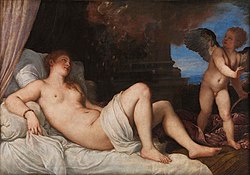 | Danaë (one of at least four versions) | 1546 | 120 × 172 cm | Museo di Capodimonte (Naples) |
 | Portrait of the Vendramin Family | 1547 | 206 × 301 cm | National Gallery (London) [26] |
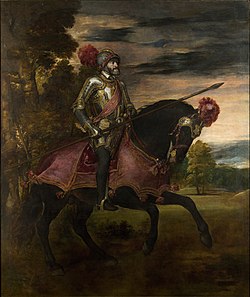 | Equestrian Portrait of Charles V | 1548 | 332 × 279 cm | Museo del Prado (Madrid) [27] |
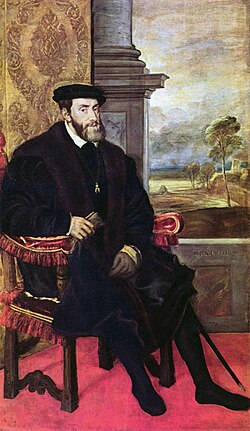 | Portrait of Charles V Seated | 1548 | 205 × 122 cm | Alte Pinakothek (Munich) |
 | Portrait of Isabella of Portugal | 1548 | 117 × 93 cm | Museo del Prado (Madrid) [28] |
 | Venus and Musician | 1548 | 148 × 217 cm | Museo del Prado (Madrid) [29] |
 | John Frederick I, Elector of Saxony in Armour | 1548 | 129 × 93 cm | Museo del Prado (Madrid) [30] |
 | Tityus | 1549 | 253 × 217 cm | Museo del Prado (Madrid) [31] |
 | Sisyphus | 1549 | 237 × 216 cm | Museo del Prado (Madrid) [32] |
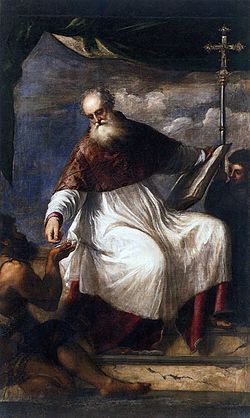 | Saint John the Almoner | c. 1549 | 229 × 156 cm | San Giovanni Elemosinario (Venice) |
 | The Fall of Man | c. 1550 | 240 × 186 cm | Museo del Prado (Madrid) [33] |
 | Mater Dolorosa | 1550 | 68 × 61 cm | Museo del Prado (Madrid) [34] |
 | Portrait of John Frederick I, Elector of Saxony | 1550–51 | 103.5 × 83 cm | Kunsthistorisches Museum (Vienna) [35] |
 | Portrait of a Lady and Her Daughter | c.1550 | 88 × 80,7 cm | Rubenshuis (Antwerp) [36] |
 | Venus with an Organist | c. 1550 | 115 × 280 cm | Gemäldegalerie, Berlin |
 | Mars, Venus and Amor | c. 1550 | 97 x 109 cm | Kunsthistorisches Museum (Vienna) |
 | Knight of Malta with a Watch | c. 1550 | 122 × 101 cm | Museo del Prado (Madrid) [37] |
 | Penitent Magdalene | c. 1550 | Museo di Capodimonte (Naples) | |
 | Saint Jerome in Penitence | 1550–1560 | 255 × 125 cm | Pinacoteca di Brera (Milan) |
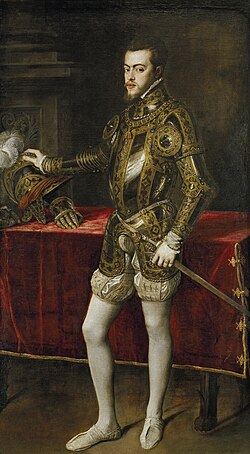 | Portrait of Philip II in Armour | 1551 | 193 × 111 cm | Museo del Prado (Madrid) [38] |
 | Portrait of Cardinal Cristoforo Madruzzo | 1552 | 230 x 131 cm | São Paulo Museum of Art (São Paulo) |
 | The Holy Trinity (La Gloria) | 1551–1554 | 346 × 240 cm | Museo del Prado (Madrid) [39] |
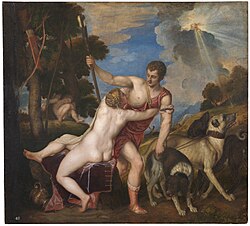 | Venus and Adonis - many different versions, with varying contributions by Titian himself. See ones in New York and Rome below. | 1553–1554 | 186 × 207 cm | Museo del Prado (Madrid) [40] |
 | Mater Dolorosa with Open Hands | 1554 | 68 × 53 cm | Museo del Prado (Madrid) [41] |
 | Christ Appearing to His Mother After His Resurrection | 1554 | ||
 | Woman Holding an Apple | c. 1550–1555 | 97.8 × 73.8 cm | National Gallery of Art (Washington, D.C.) |
 | Danaë and the Shower of Gold | 1554 | 128 × 178 cm | Museo del Prado (Madrid) [42] |
 | Perseus and Andromeda | c. 1554–1556 | 175 × 189.5 cm | Wallace Collection (London) |
 | Portrait of Philip II | c. 1554 | Museo di Capodimonte (Naples) | |
 | Portrait of Queen Christina of Denmark | c. 1555–1556 | 112 × 83 cm | National Museum of Serbia (Belgrade) |
 | Venus with a Mirror | c. 1555 | 124.5 × 105.5 cm | National Gallery of Art (Washington, D.C.) [43] |
 | Venus and Adonis - many different versions, with varying contributions by Titian himself. See one in the Prado above, and in Rome below. | c. 1555 | 106 × 133 cm | Metropolitan Museum of Art (New York) |
 | Filippo Archinto, Archbishop of Milan | c. 1555 | 118 × 94 cm | Metropolitan Museum of Art (New York) |
 | Venus and the Lute Player | c. 1555–1565 | 150 × 196 cm | Fitzwilliam Museum (Cambridge) |
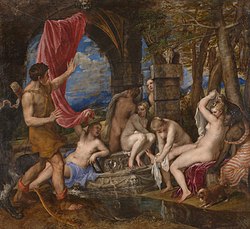 | Diana and Actaeon | 1556–1559 | 190.3 × 207 cm | National Gallery (London) [44] / National Gallery of Scotland (Edinburgh) [45] |
 | Portrait of Fabrizio Salvaresio | 1558 | 112 × 88 cm | Kunsthistorisches Museum (Vienna) |
 | Crucifixion | 1558 | 371 × 197 cm | Church of San Domenico, (Ancona) |
 | The Martyrdom of Saint Lawrence | 1559 | 500 × 280 cm | I Gesuiti (Venice) |
 | Diana and Callisto | 1559 | 187 × 205 cm | National Gallery (London) / National Gallery of Scotland (Edinburgh) [46] |
 | The Entombment | 1559 | 137 × 175 cm | Museo del Prado (Madrid) [47] |
 | The Rape of Europa | 1559–1562 | 185 × 205 cm | Isabella Stewart Gardner Museum (Boston) |
 | Annunciation | 1559–1564 | 410 × 240 cm | San Salvador (Venice) |
 | The Death of Actaeon | c. 1559–1575 | 178.4 × 198.1 cm | National Gallery (London) [48] |
 | Salome | c. 1560 | 87 × 80 cm | Museo del Prado (Madrid) [49] |
 | Girl with a Platter of Fruit | c. 1558 | 102 x 82 cm | Gemäldegalerie (Berlin) |
 | Venus and Adonis - many different versions, with varying contributions by Titian himself. See ones in the Prado and New York above. | c. 1560 | 187 × 184 cm | Galleria Nazionale d'Arte Antica (Rome) |
 | Madonna and Child with Saints Luke and Catherine of Alexandria | c. 1560 | 127.8 × 169.7 cm | (Bought by a private bidder on 28 January 2011) |
 | Nicolò Zen | c. 1560-1565 | 125.7 x 96.8 cm | National Trust (Kingston Lacy) |
 | Self-portrait | c. 1560–1562 | 96 × 72 cm | Gemäldegalerie, Berlin |
 | The Tribute Money | c. 1560–1568 | 112.2 x 103.2 cm | National Gallery (London) [50] |
 | The Penitent Magdalene | c. 1565 | 118 × 97 cm | Hermitage Museum (Saint Petersburg) |
 | Saint Dominic | c. 1565 | 97 × 80 cm | Galleria Borghese, (Rome) |
 | Allegory of Prudence | c. 1565–1570 | 76.2 × 68.6 cm | National Gallery (London) [51] |
 | Venus and a Lute Player | c. 1565-1570 | 165 × 209 cm | Metropolitan Museum of Art (New York) |
 | The Entombment | 1566 | 130 × 168 cm | Museo del Prado (Madrid) [52] |
 | Self-portrait | c. 1567 | 86 × 65 cm | Museo del Prado (Madrid) [53] |
 | Portrait of Jacopo Strada | c. 1567–1568 | 125 × 95 cm | Kunsthistorisches Museum (Vienna) [54] |
 | Judith with the Head of Holofernes | c. 1570 | 113 × 95.3 cm | Detroit Institute of Arts (Detroit) |
 | Salome | c. 1570 | 114 × 96 cm | Private collection |
 | Salome | c. 1560–1570 | 90 × 83.3 cm | National Museum of Western Art (Tokyo). Attributed to Titian and workshop |
 | Tarquin and Lucretia | 1571 | 189 × 145 cm | Fitzwilliam Museum (Cambridge) |
 | Punishment of Marsyas | c. 1570-1576 | 212 × 207 cm | National Museum, (Kroměříž) |
 | Nymph and Shepherd | c. 1570–1576 | 149.7 × 187 cm | Kunsthistorisches Museum (Vienna) [55] |
 | Pietà | c. 1570–1576 | 351 × 389 cm | Gallerie dell'Accademia (Venice) |
 | The Crowning with Thorns | c. 1570–1576 | 280 × 181 cm | Alte Pinakothek (Munich) |